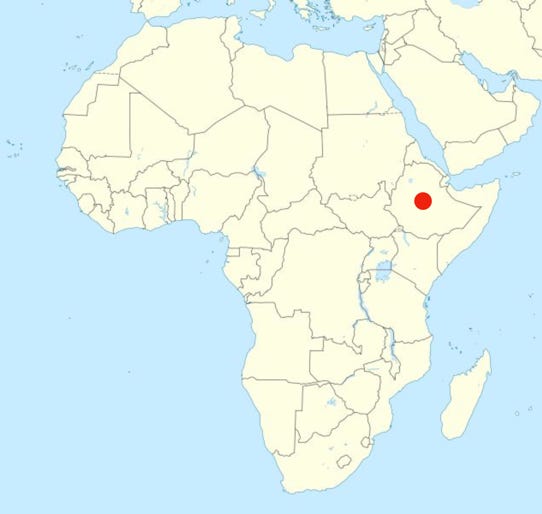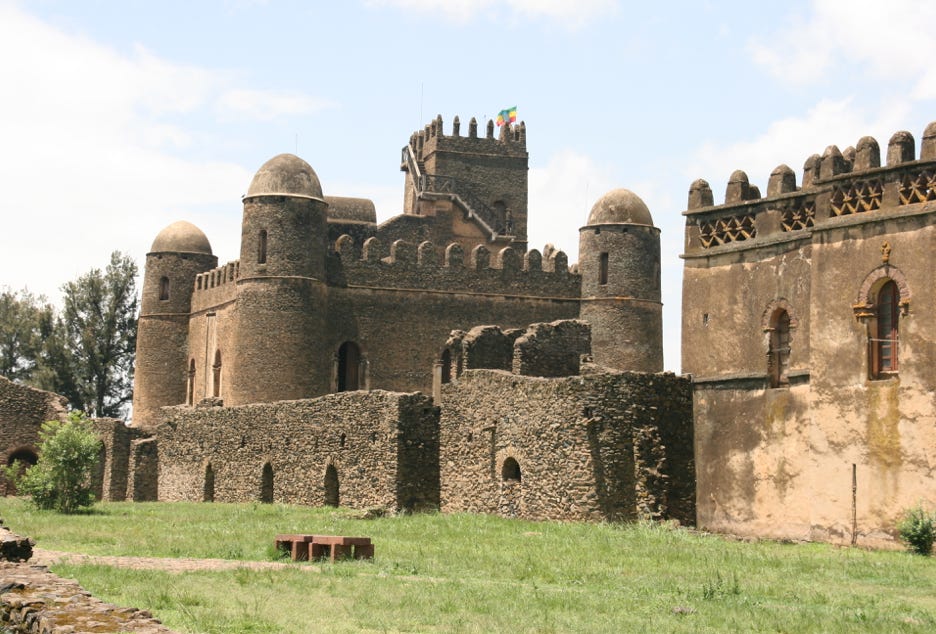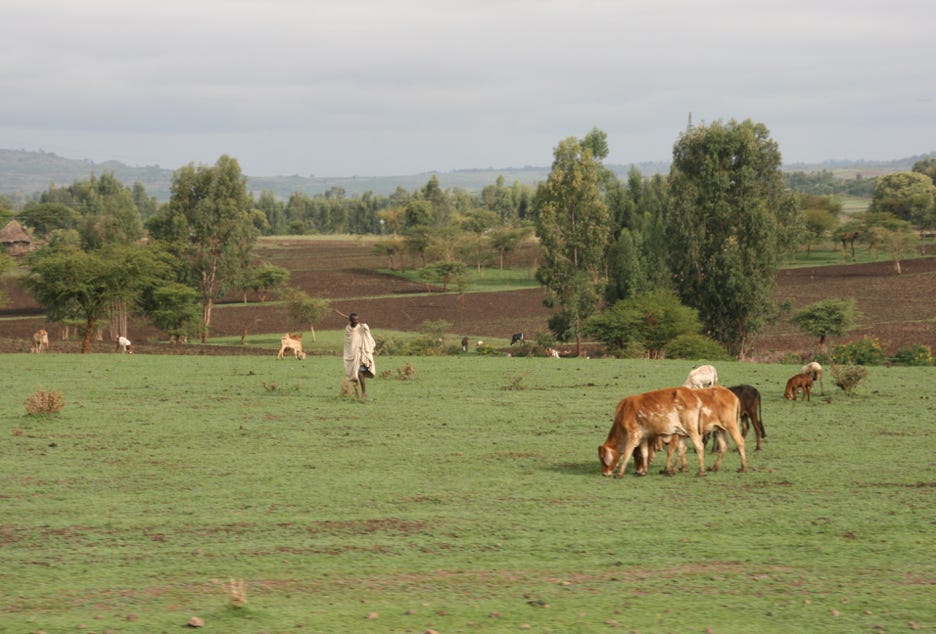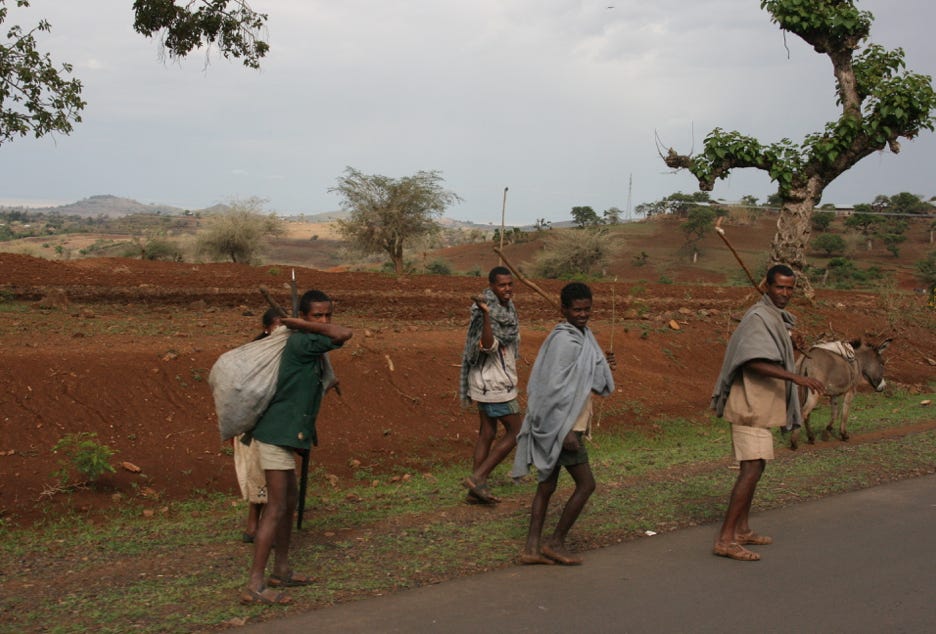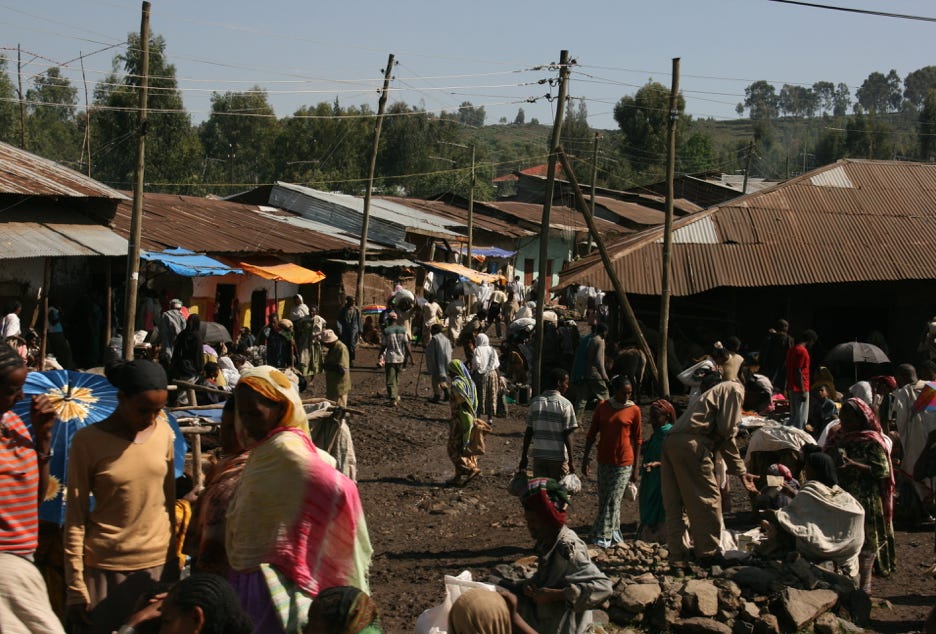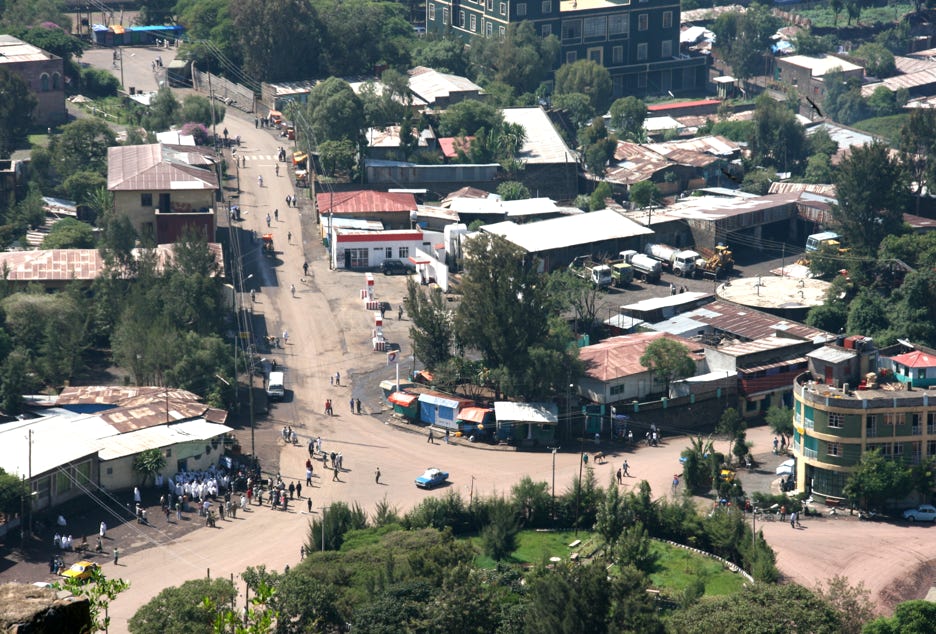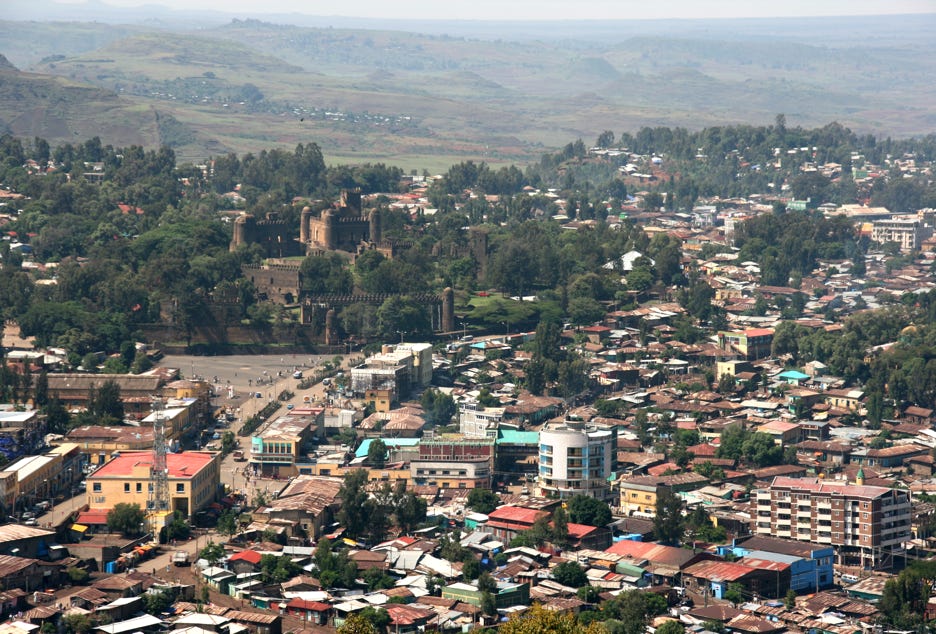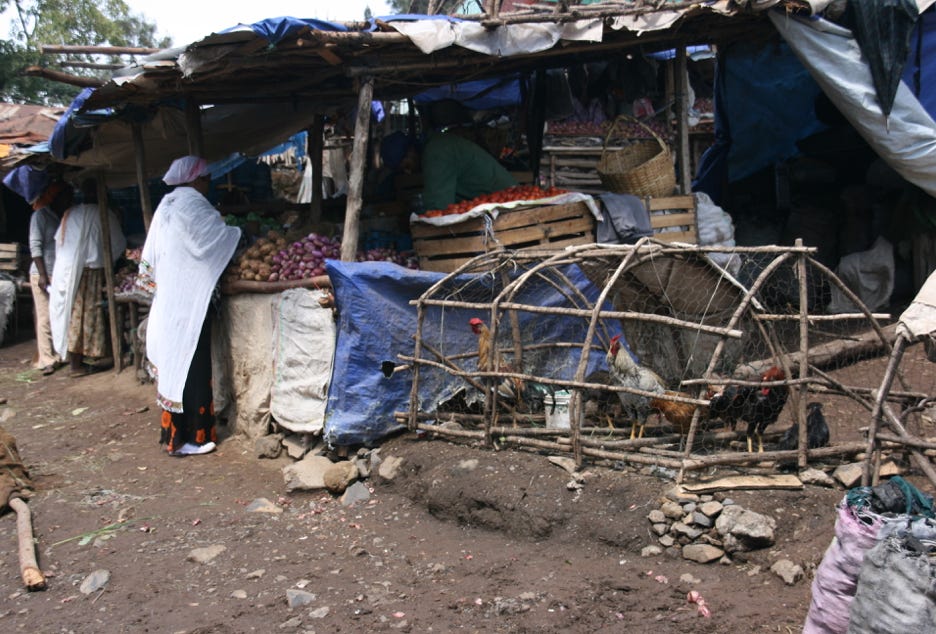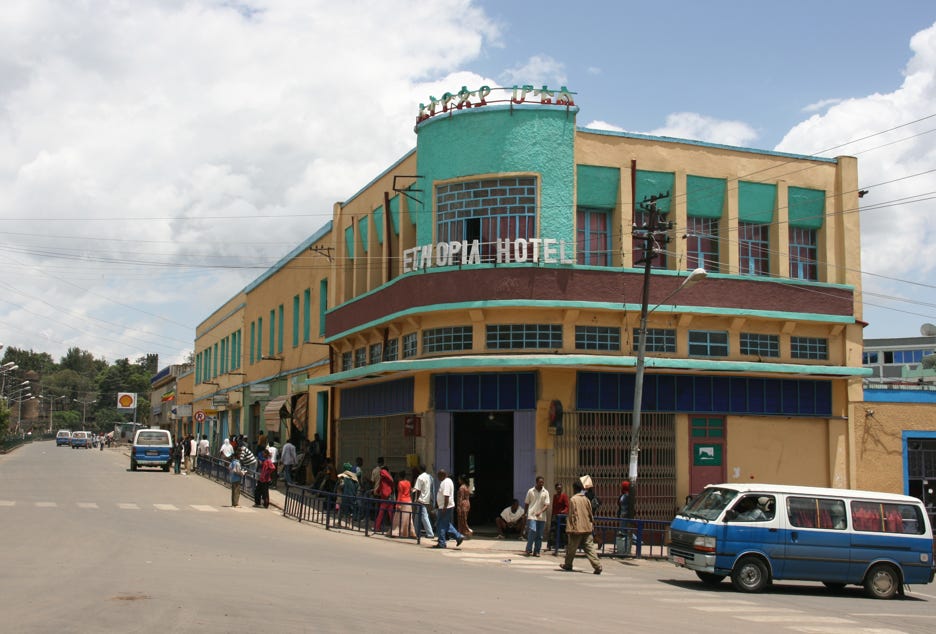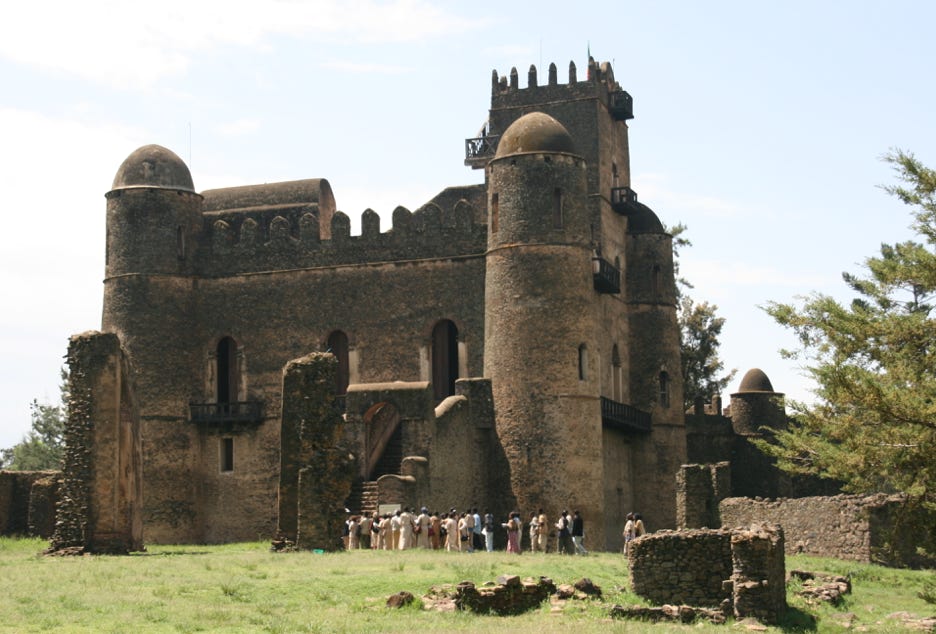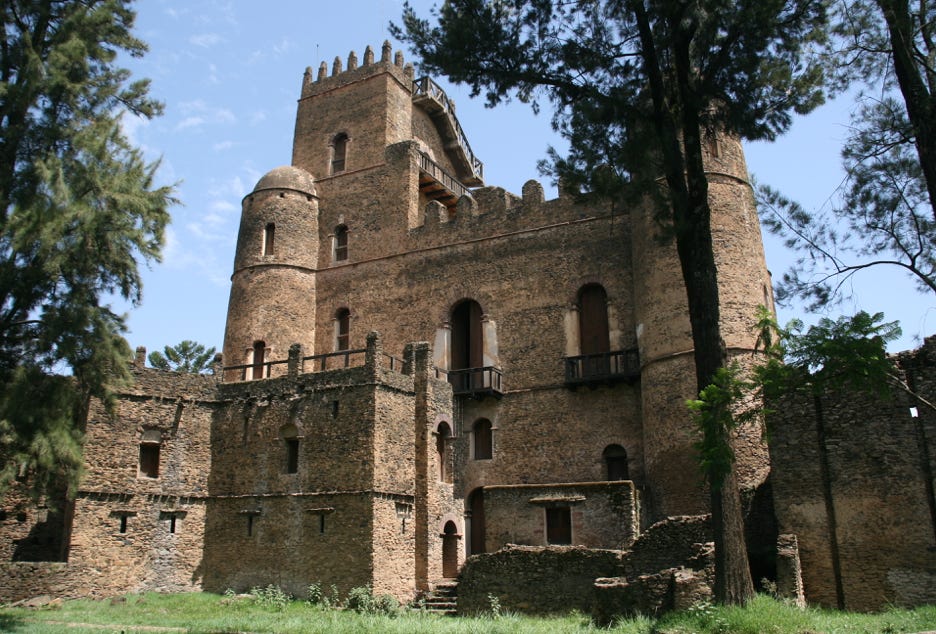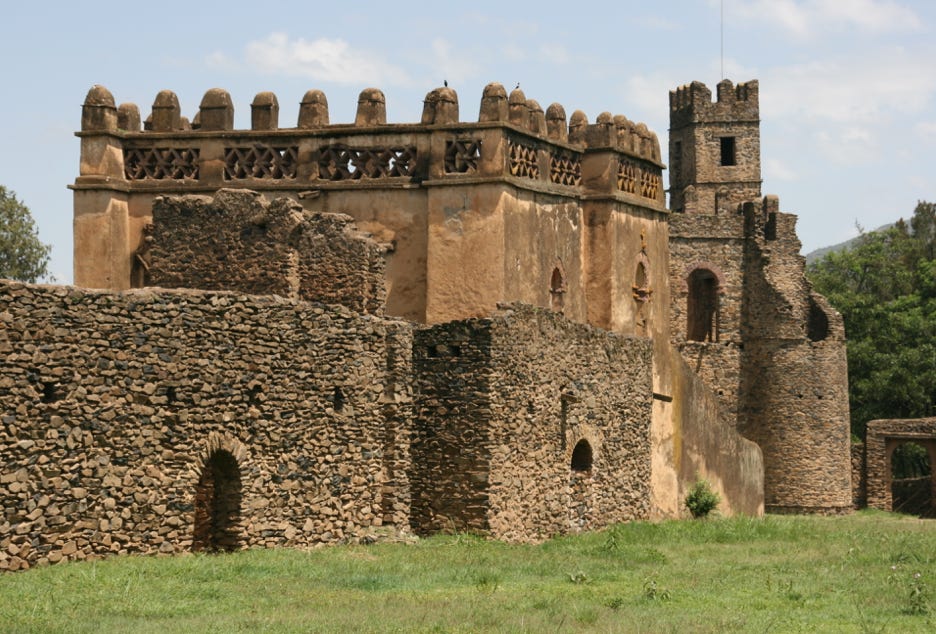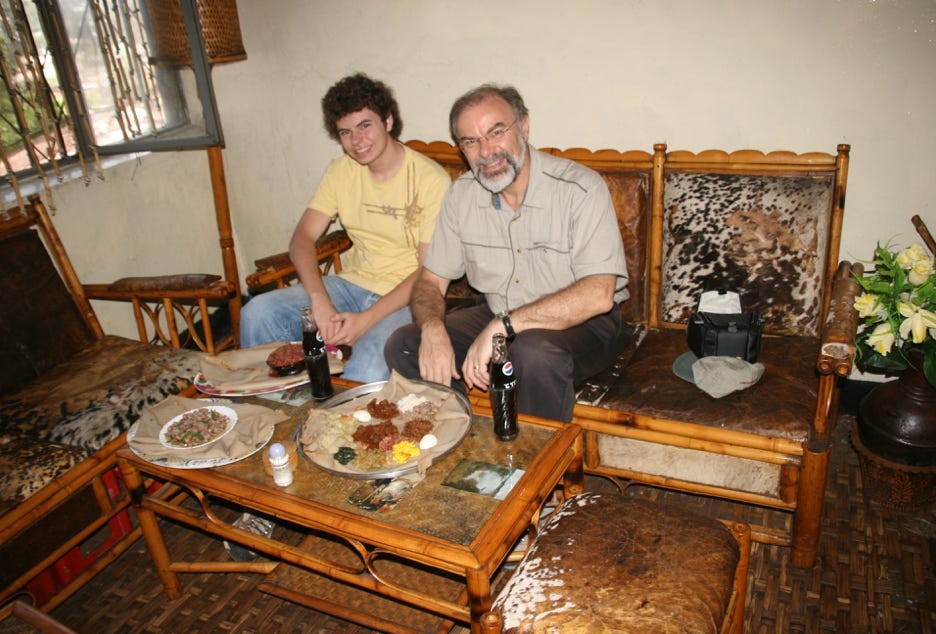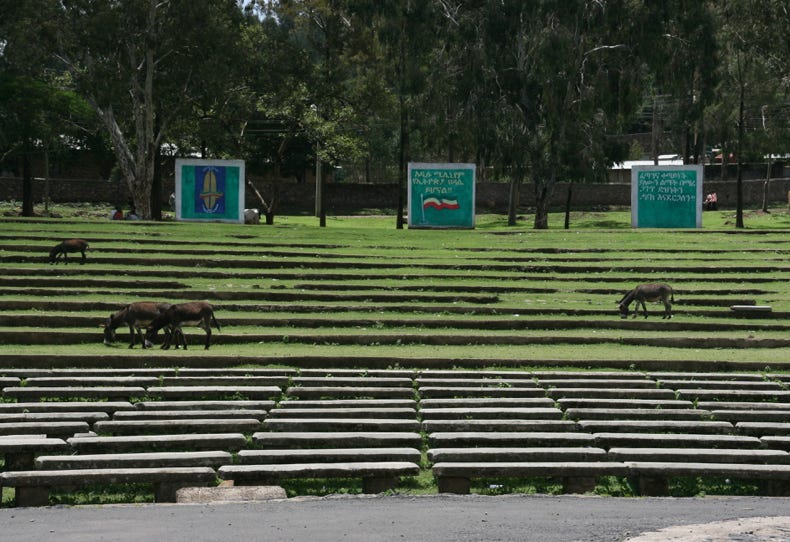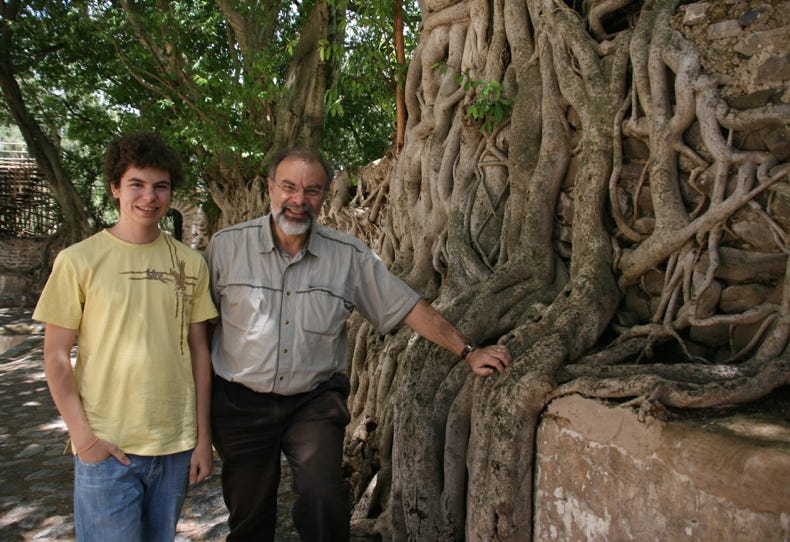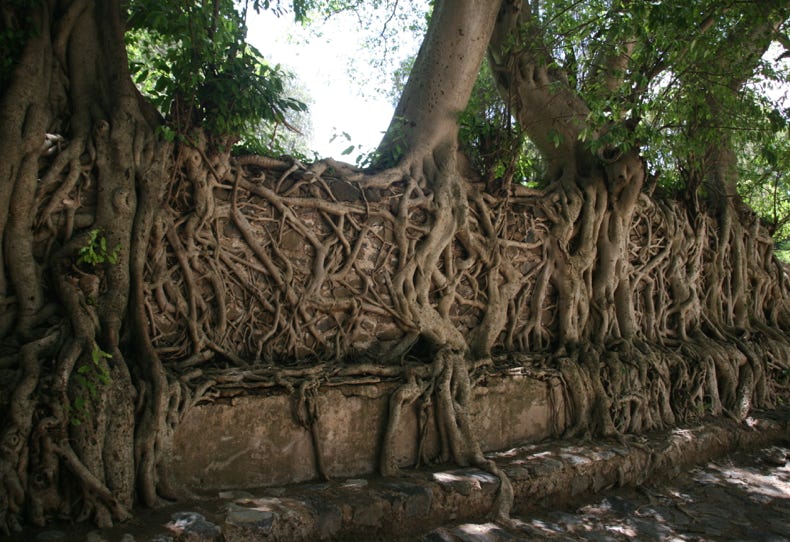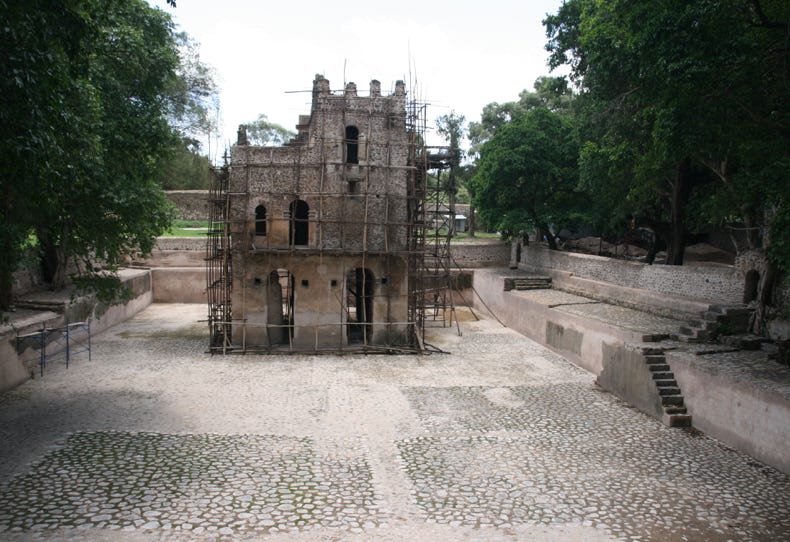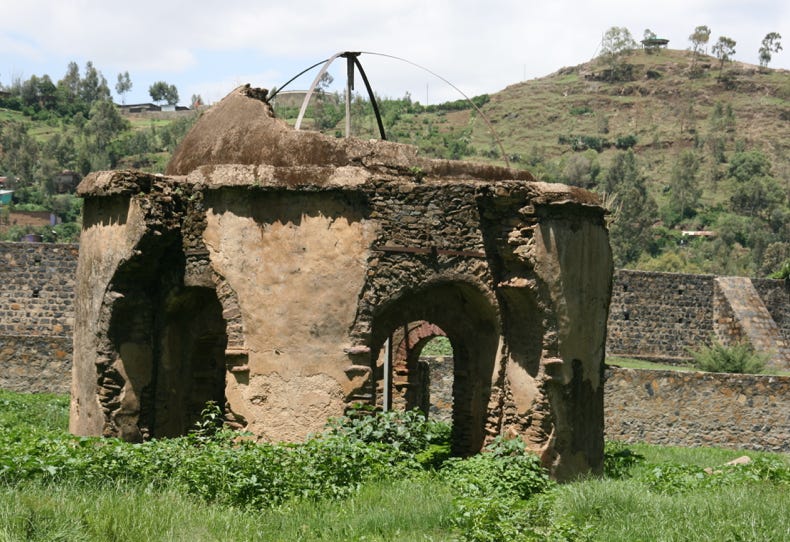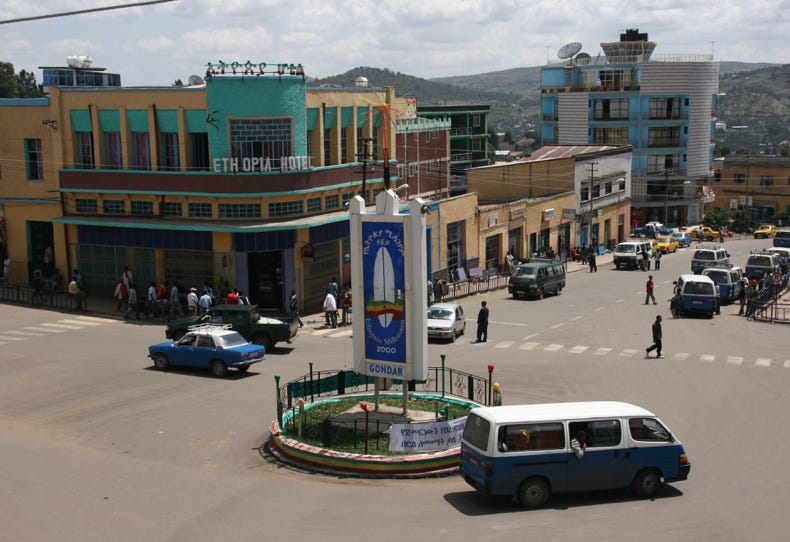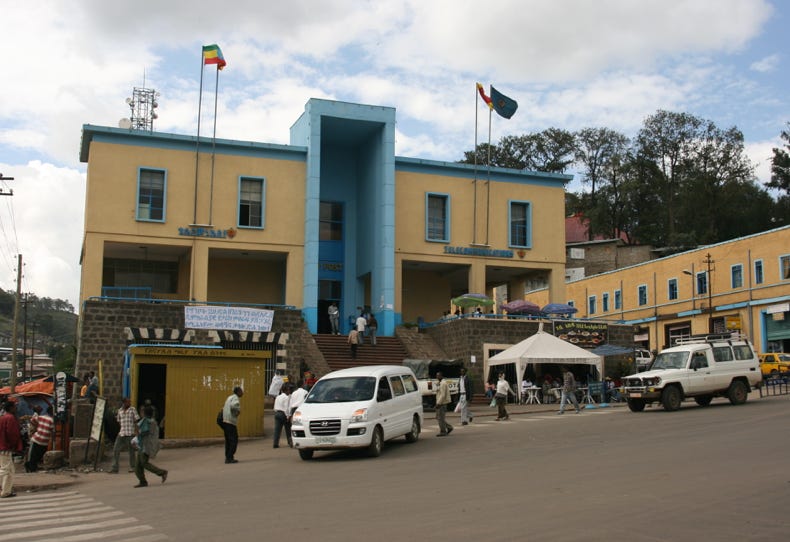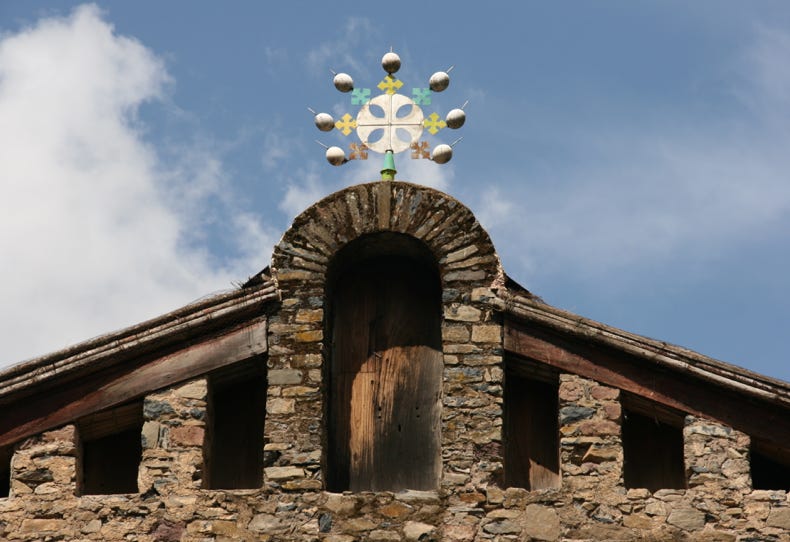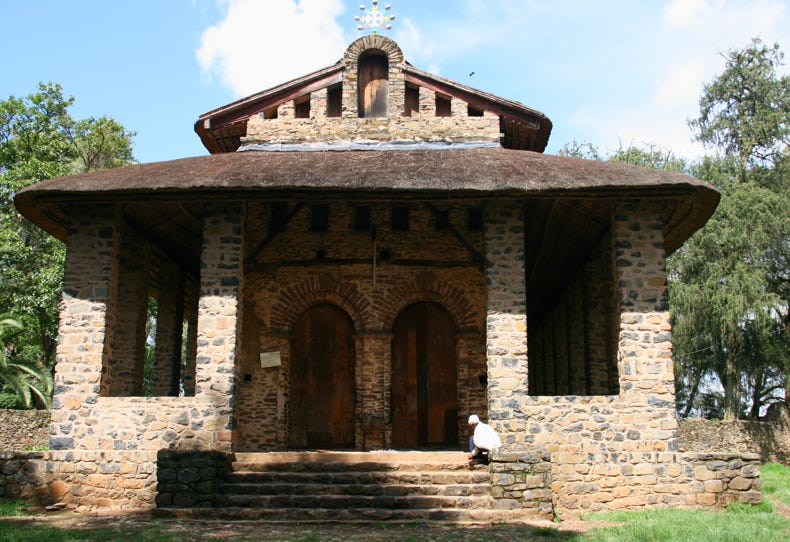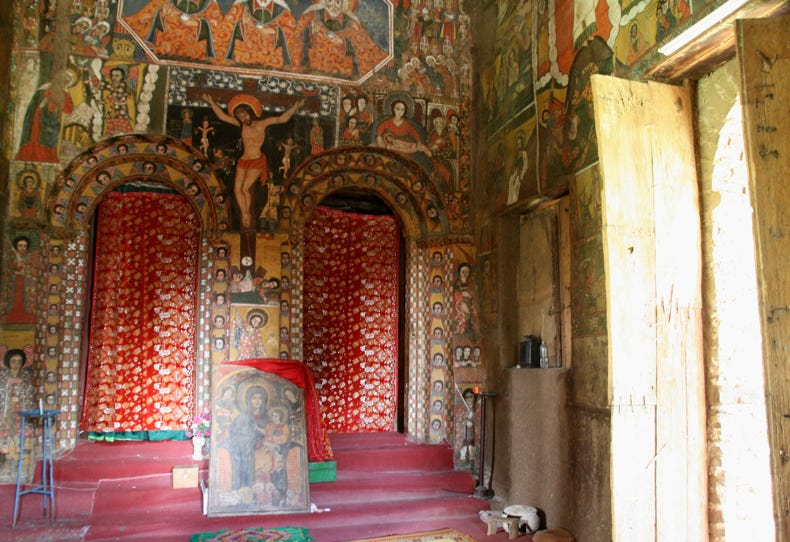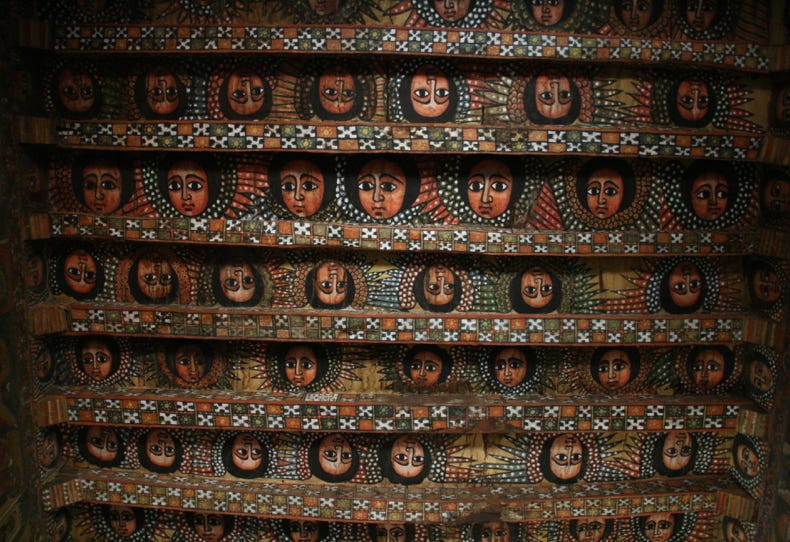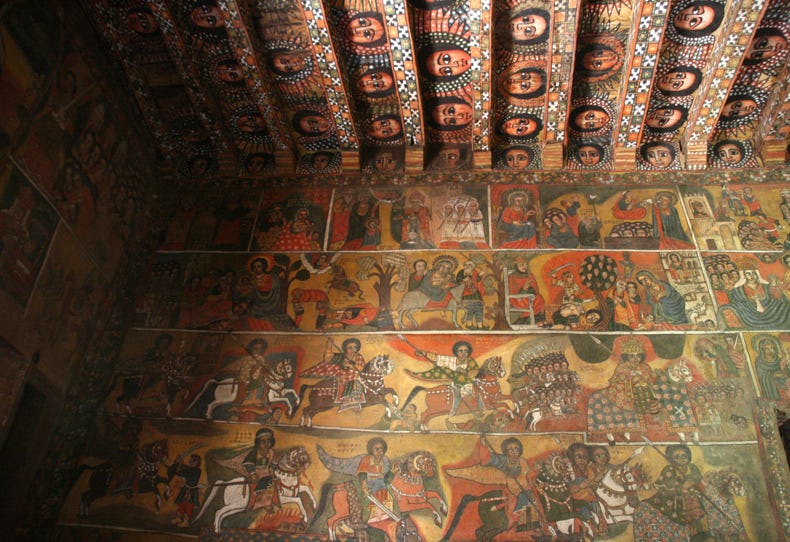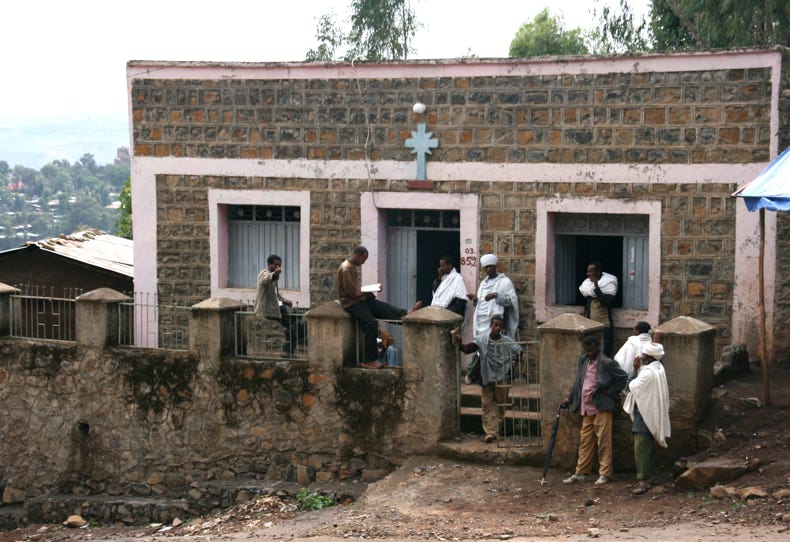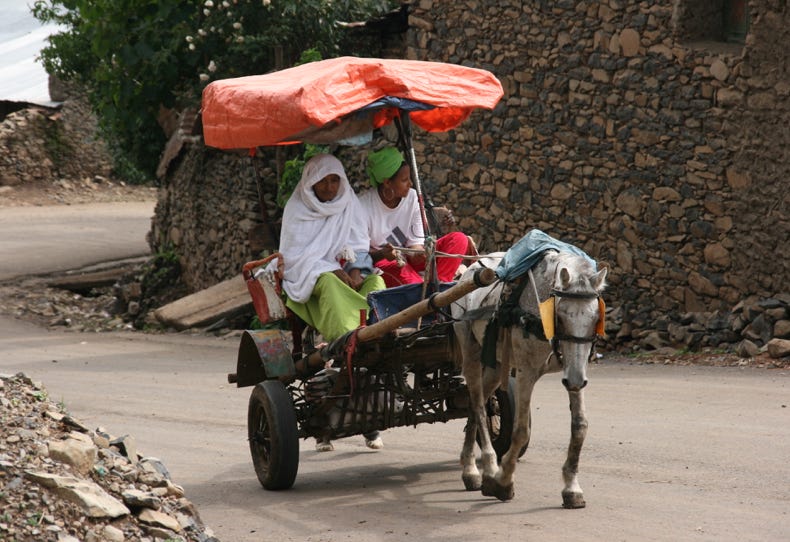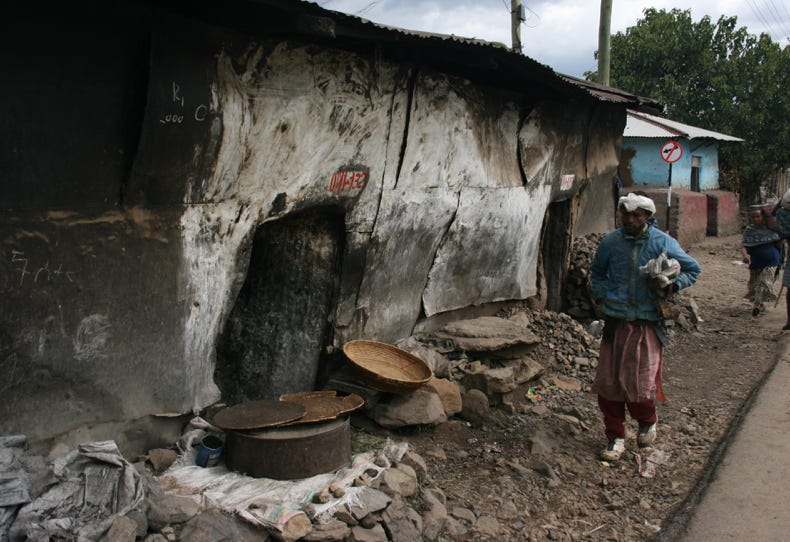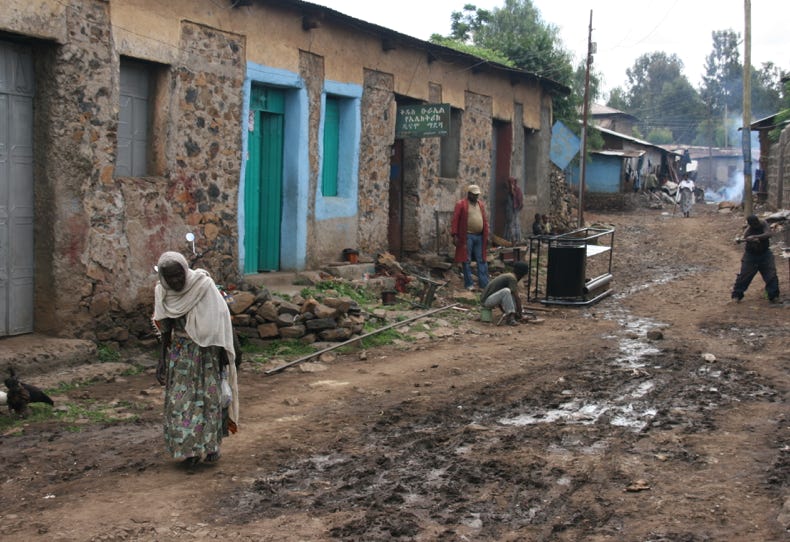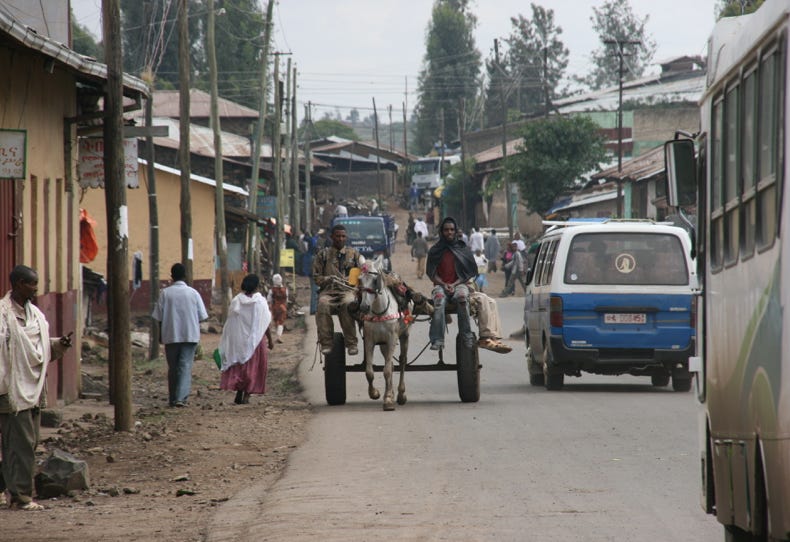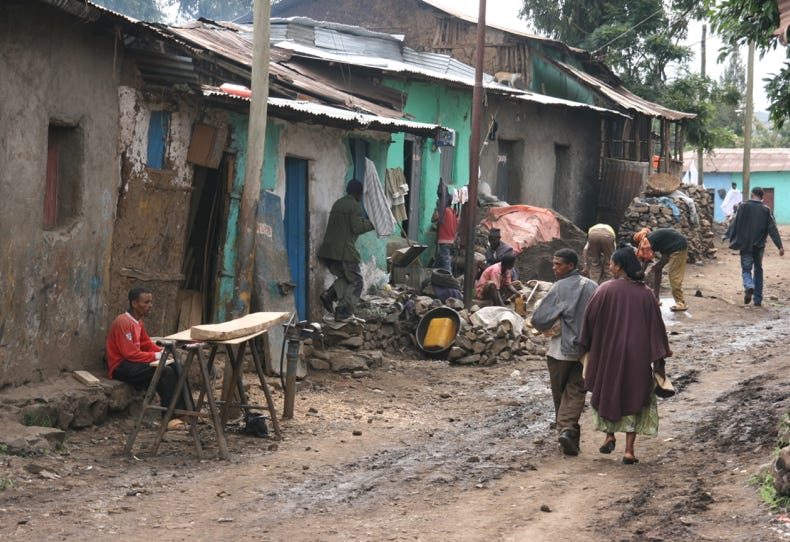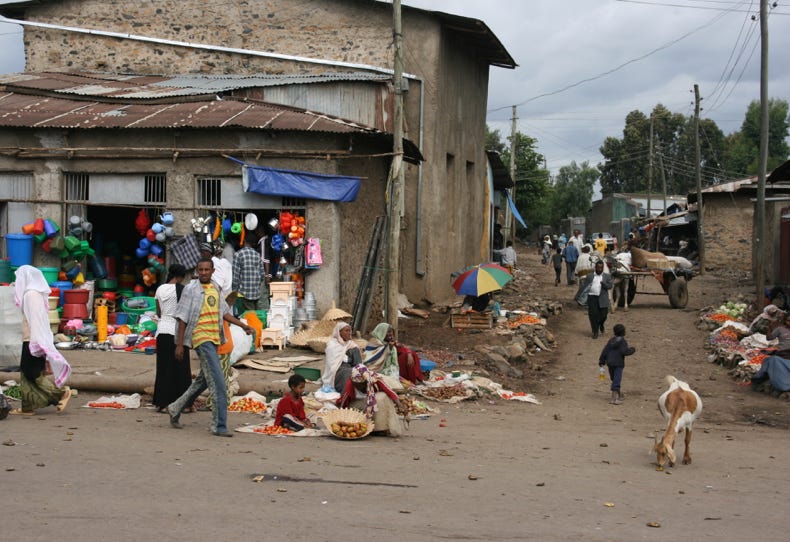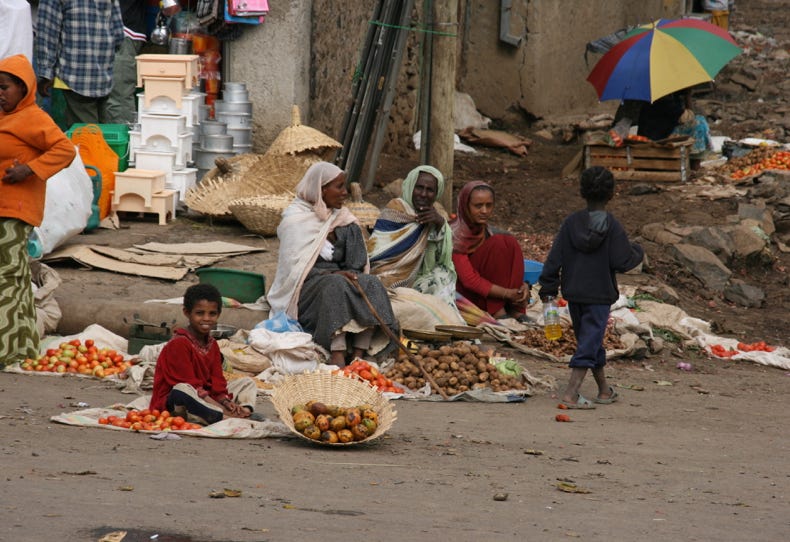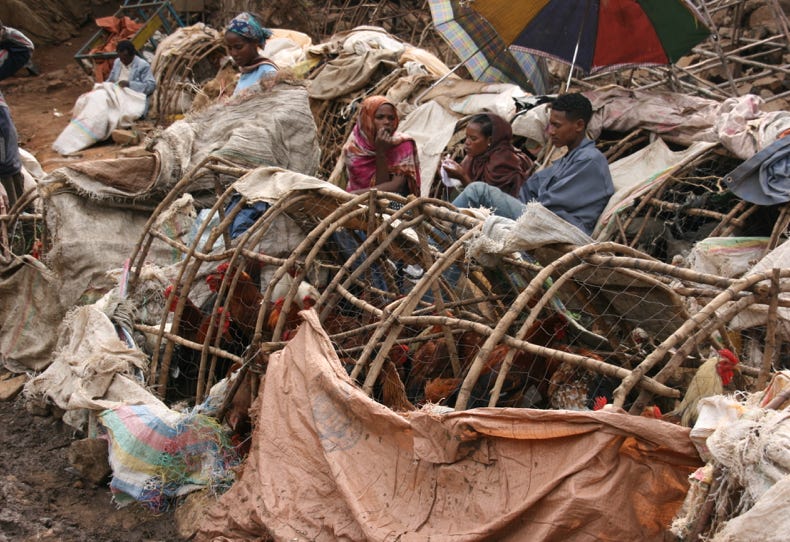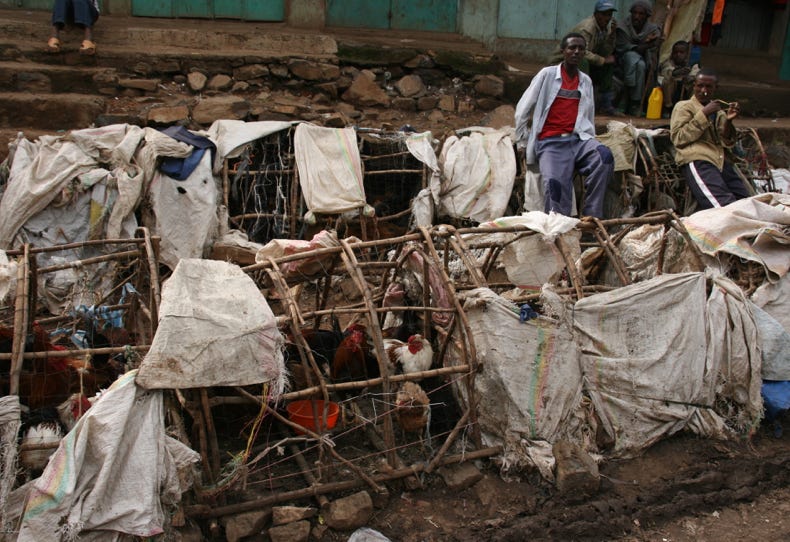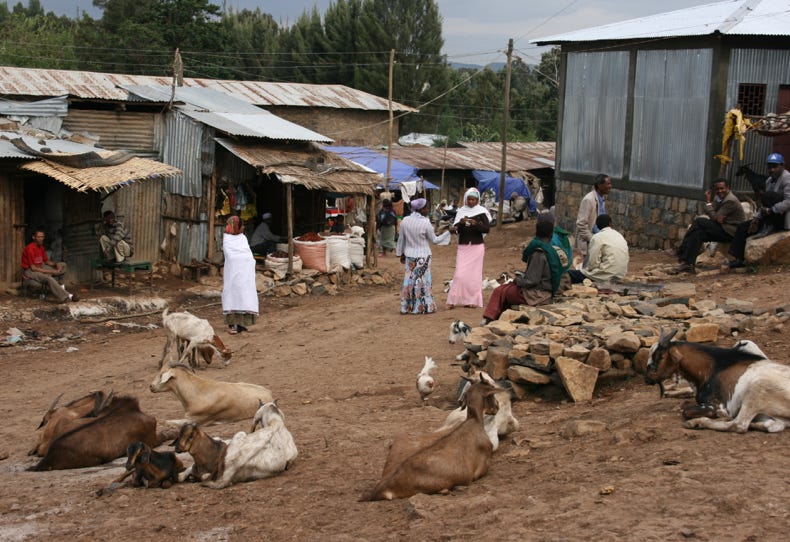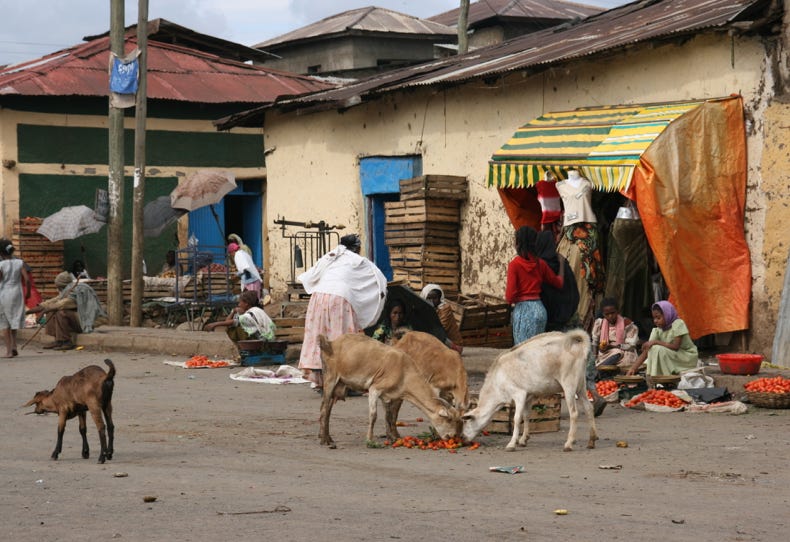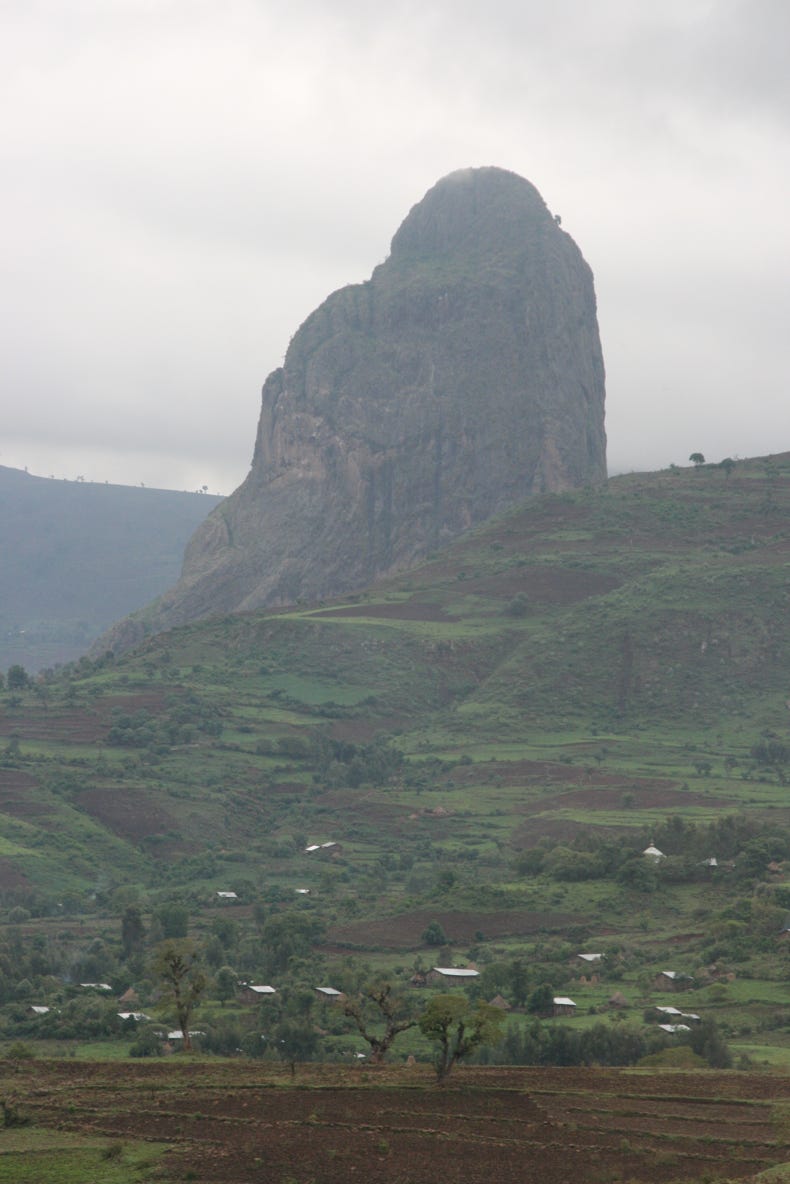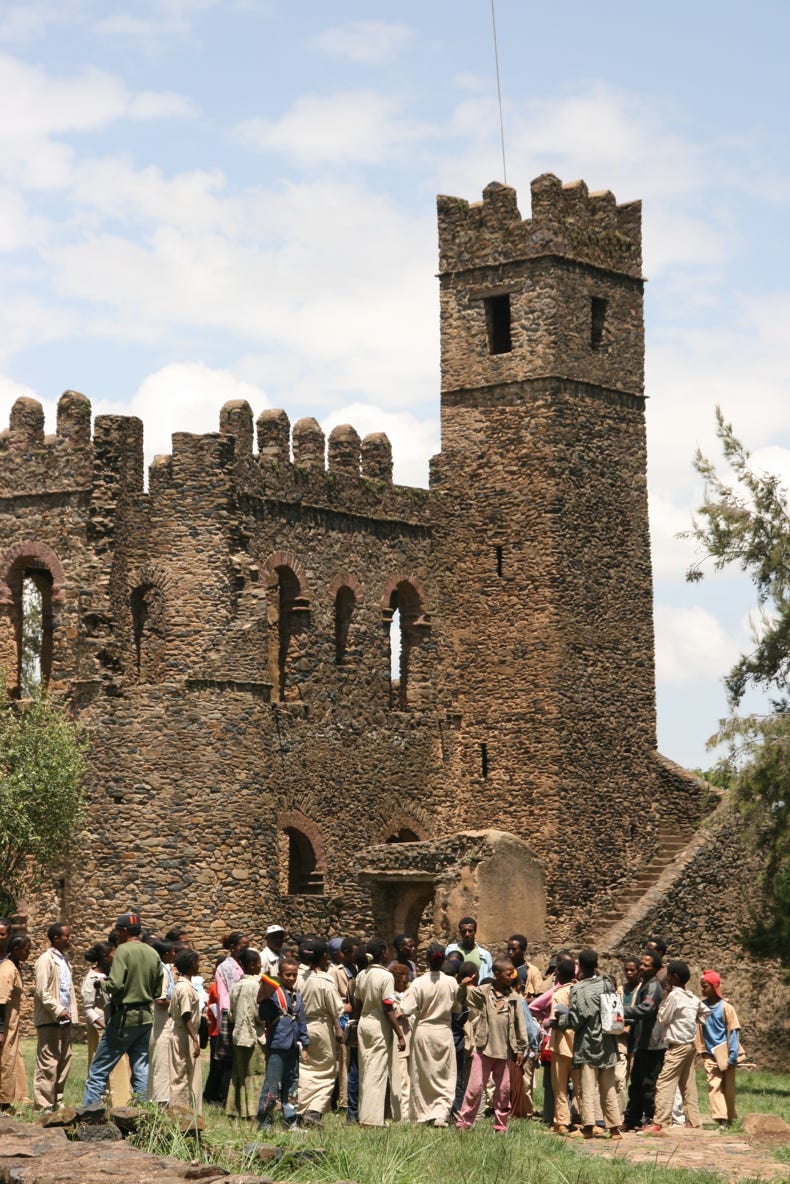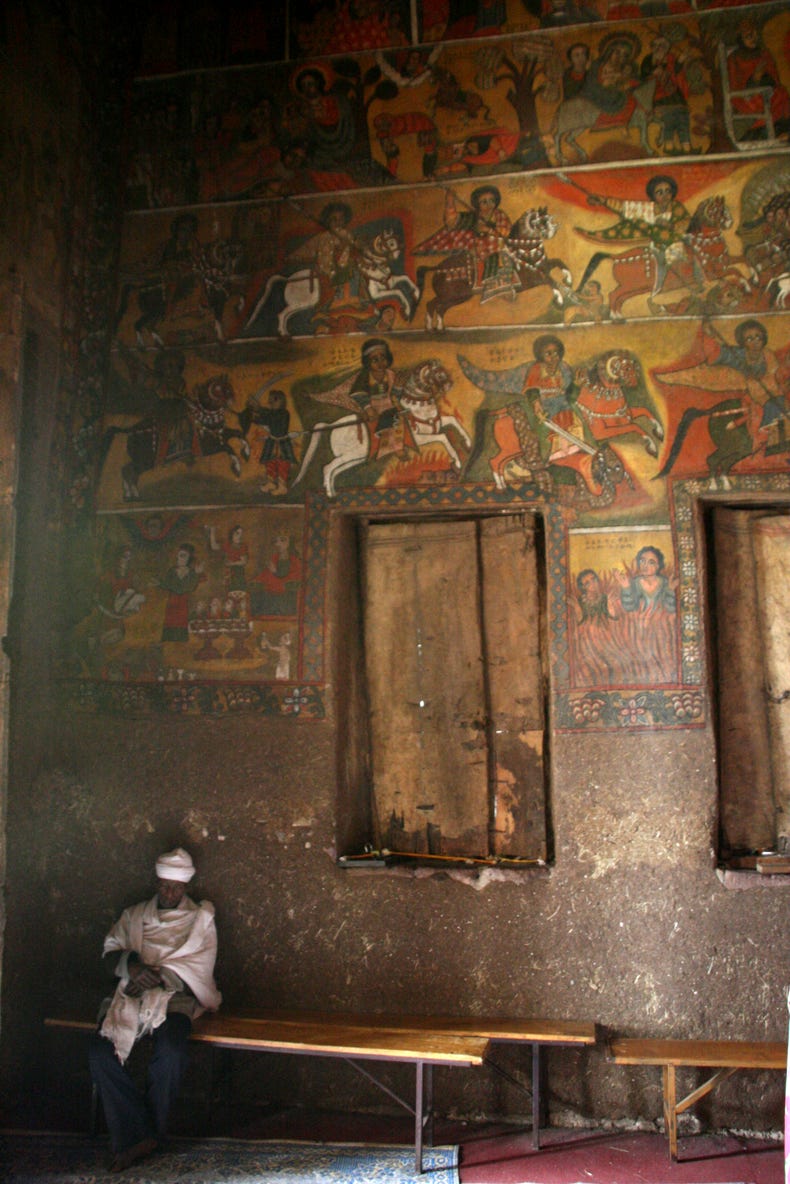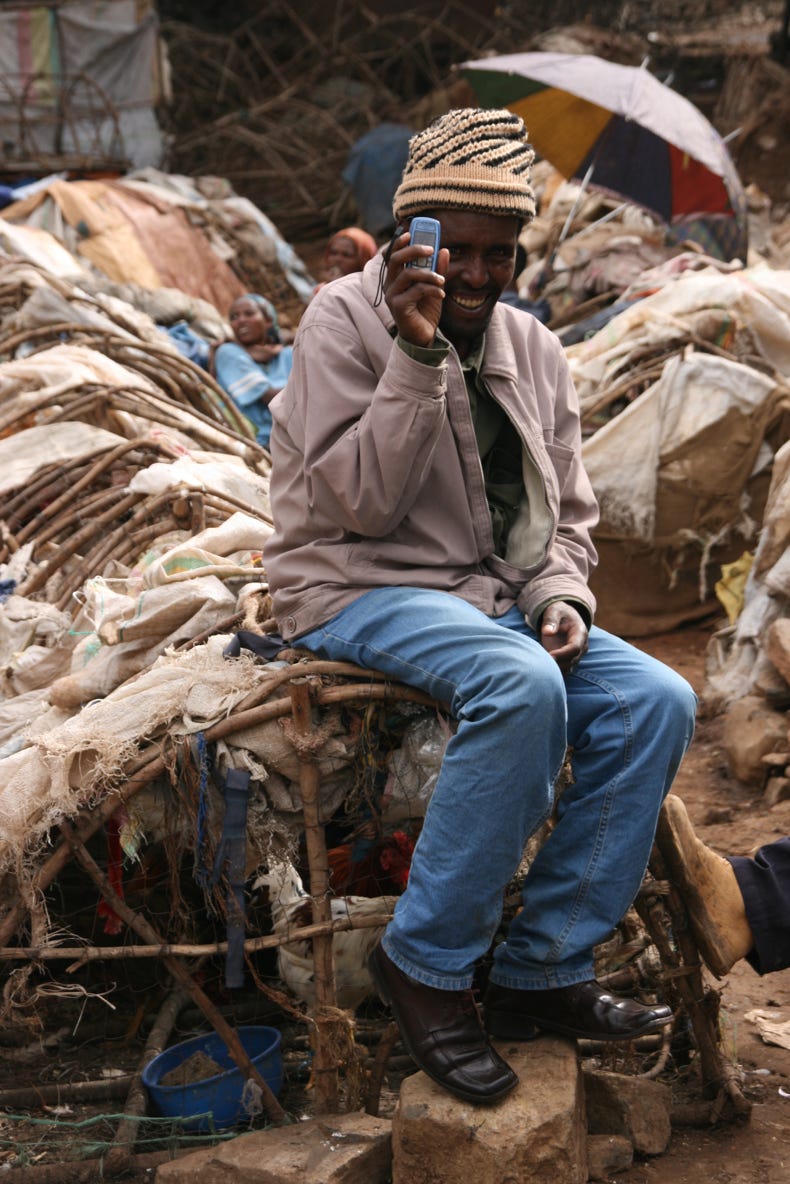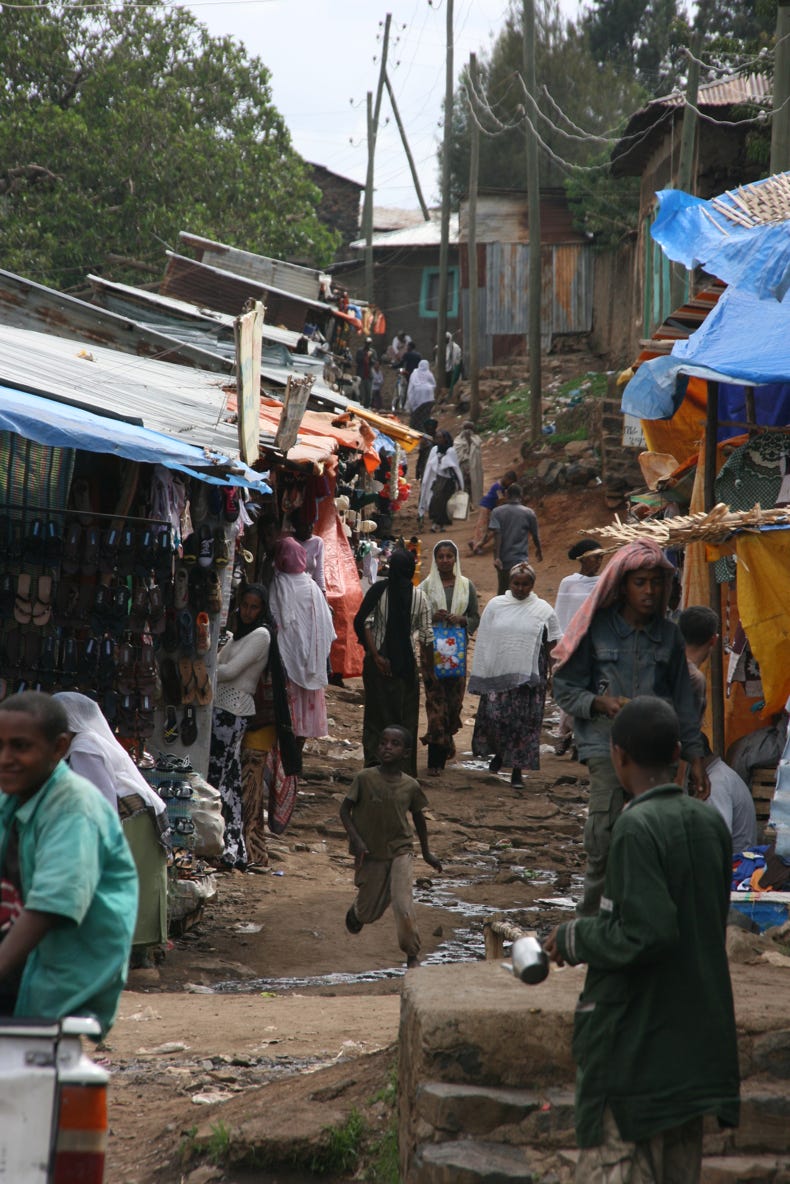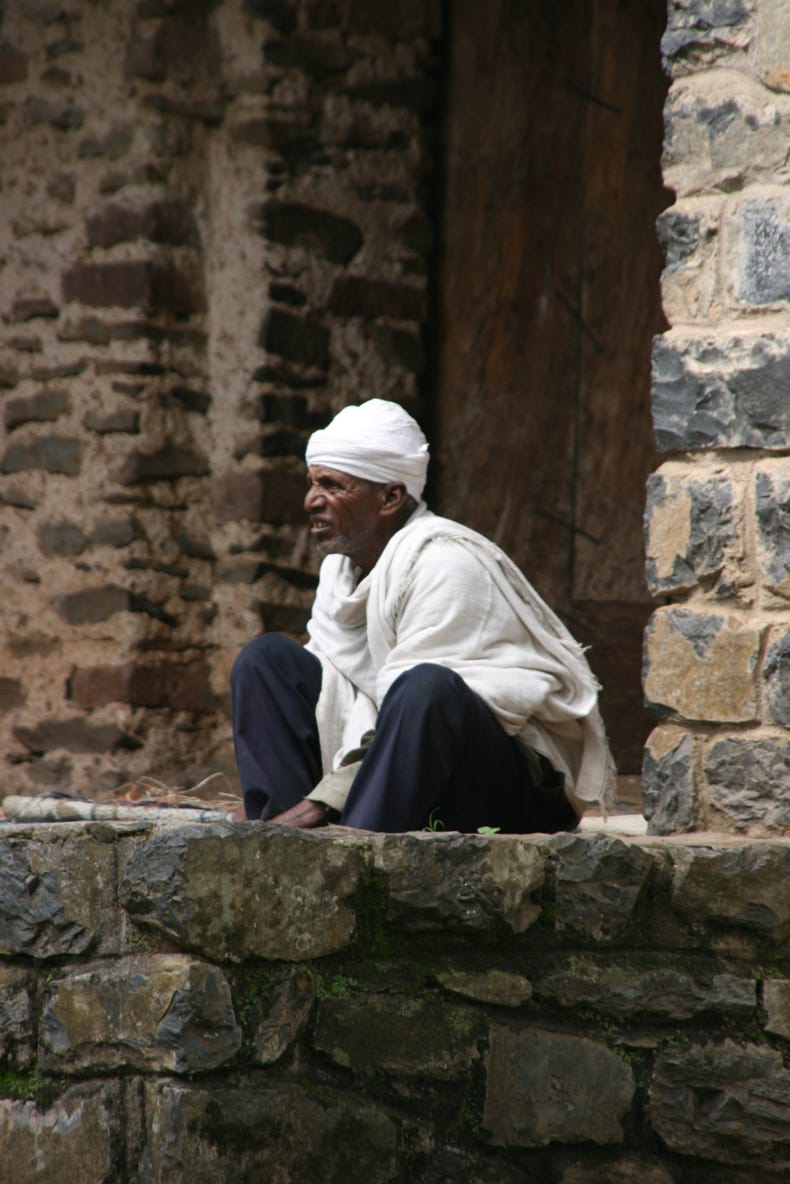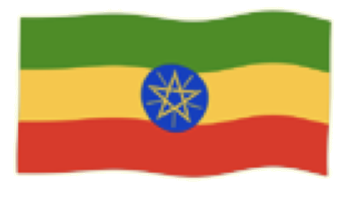

My alarm rang right on schedule at 5:30 am. I must have been in a deep REM cycle of sleep, because I remember being very frustrated that I would never hear the reaction of my fellow school principals to the video I was showing them (on my laptop, in my dream) about Barack Obama and George Bush. Showing the video had been an exasperating experience in itself as there had been a glitch in copying the file to my laptop, but I had to put all that behind me as Ethiopia beckoned with the promise of much bigger and certainly more significant glitches. The American presidential race would just have to take a back seat for me. Actually, like all outside news events, it was taking a back seat anyway – Andrew and I have have not had access to any news from the outside world for several days now, nor does it seem likely that we will be catching up with world events for quite some time to come.
After a cold shower (there being no hot water), we had breakfast and then headed out to catch our minibus for the three hour drive from Bahar Dar to Gonder (also transliterated as Gondar). This trip presented a good chance to see some countryside when compared with the wimpish option of flying (Bahar Dar to Gondar is a 17 minute flight in a Fokker F-50!). It was raining as we left Bahar Dar, and it remained overcast for much of the drive, although the rain did stop soon after leaving Bahar Dar, and the sky gradually brightened as we approached Gonder. The drive was a great experience, being on a smooth road (and therefore, by necessity it seems, driven at death-defying breakneck speed). The road just north of Bahar Dar was smooth and straight, although the wreckage of a considerable number of tanks and armoured personnel carriers beside the road was a little off-putting until they became so commonplace that they ceased to be noticeable.
With the beginning of the onset of the rains, there was lots of activity in the fields, with many farmers were engaged in ploughing fields using cattle to pull the ploughs. In general, the countryside was green and verdant, even though the rains had not yet really begun in earnest. As usual on Ethiopia’s roads, lines of people could be seen walking beside the roadway, many carrying goods on their heads, especially large bundles of fuelwood. The disturbing environmental cost of the fuelwood was evident on many sections of the drive, however, where grotesquely distorted remains of trees could be seen, seeming to survive - barely - despite the repeated savage butchering of their branches for fuelwood. About mid- way on the journey, the road began a twisting climb up into the volcanic mountains, evidence of ancient volcanic activity being seen in several steeply-sided volcanic plugs and necks from ancient eruptions. The climb was necessary to bring us to Gonder, which lies at an altitude of 2210 metres.
Gonder is a very pretty city, set on steeply-sided hillsides with a population of 160,000 people. The city is sometimes referred to as “Ethiopia’s Camelot” because of the abundance of grand 17th century castles found here. During the 17th century, the town marked the intersection of three major caravan routes, and in 1636 Emperor Fasiladis declared the city to be the capital of his empire. When he died in 1667, the city already had a population of 65,000 people, and most of the palaces in the city date from around that era.
Other later phases in the city’s history have affected its appearance too. Gonder’s town centre is characterised by a beautiful collection of art deco buildings constructed by the Italians during their occupation in the late 1930s and early 1940s. Most of them are painted in a distinctive yellow colour, highlighted by various hues of blue and green.
Upon reaching Gonder, our first stop was the Hotel Goha, where we deposited our luggage. The rooms in the Goha Hotel had an identical design to those in the Hotel Tana in Bahar Dar where we had stayed the previous night. Like the earlier hotel, the rooms in the Hotel Goha looked great at first sight, but were considerably less impressive on closer examination - no hot water like the previous night, but here there was no electricity whatsoever as well (until they turned on a generator in the evening gloom at 7:00 pm that night).
Having arrived in time to do some sightseeing before lunch, Andrew and I headed to the Royal Enclosure, a vast 70,000 square metre complex of 17th century palaces built on a hill overlooking the centre of Gonder. The Royal Enclosure can be seen towering over the city centre in the image above-right (like all images throughout this Travel Diary, it can be enlarged by clicking). It is hard to do justice here to the diverse array of buildings within the walls of the compound, each with its own tales of intrigue, assassinations, desecration, restoration, and various architectural oddities. The image at the top of this page shows the largest and oldest of the palaces, the 32 metre tall Fasiladas’ Palace. Yet it is only one of several castles, set amidst various other structures. Having walked through the palaces this morning, I can understand why Gonder is likened to Camelot. Quite simply, it is not what most people would expect to find in a medium-sized Ethiopian town!
Having spent as much of the morning as we could in the Royal Enclosure, our next stop was lunch. We found a small restaurant directly across the road from the entrance to the Royal Compound, and it certainly scored points for original decor, with pheasants and ducks walking around our feet while we ate. Andy and I both followed yesterday’s lunch experience by ordering various combinations of injera once again.
After lunch, we went first to Fasilada’s Bath. Built in the mid-1600s as an open-air royal swimming pool, this spot gets a very positive review in Lonely Planet’s Ethiopia Guidebook, but I am struggling to understand why. It is a large, dry rectangular pit in the ground with a building at one end; the building is described as ‘charming’ by Lonely Planet, but how anyone could know what it looks like through the tangle of scaffolding being used for its restoration, I don’t know. The most interesting aspect of the complex (for me) was a series of snake-like tree roots entangling some of the side walls in a manner reminiscent of Angkor Wat in Cambodia. The site’s escort guide, on the other hand, was much more excited by taking us to the periphery of the site to show us Zobel’s Mausoleum. Zobel was one of the emperor’s horses, and
when it died, the emperor ordered that a dome-roofed mausoleum be built to house the horse’s body. It is now in a sorry state of repair, with a collapsed roof and crumbling walls - not that it would have been all that impressive when it was first built either. Feeling somewhat underwhelmed that I was standing looking at a small, unimpressive, crumbling mausoleum for a dead horse, I tried to feign interest by asking “when they buried the horse, did they bury it standing up or lying down?”. It seemed like a good question to me (given my largely uninspired state of mind), but the withering look from the local guide as he answered me (“lying down of course”) told me that my efforts to show interest had fallen a tad short of requirements.
It didn’t matter though, as the afternoon got much more interesting after the let-down of Zobel’s Mausoleum. We took half an hour out to have a coffee and a mango juice at a small cafe overlooking Gonder’s main art deco square, and then went to the Debre Berhan Selassie Church. Built in the 17th century, this unassuming building houses a wonderful collection of original, unrestored frescoes that richly illustrates biblical history, Christian teaching,
church history and teachings in brightly coloured paintings covering the walls of the building. Unfortunately, Gonder was experiencing its regular scheduled one-day-in-four without electricity today, so we had to view the frescoes by means of the tiny trickle of daylight that could filter in through the doors. But wonderful as the walls were, it was the ceiling that was simply mesmerising. The ceiling had images of 104 archangels, each reminiscent of a Mona Lisa in naive style with that oh-so-similar quizzical smile. The assembly of archangels soaring over the coloured frescoes was almost hypnotic, despite the dark gloom, and despite no flash photography being allowed (hence the poor picture quality here - sorry!).
Andrew and I were interested to get a taste of everyday life in Gonder, so we went off to the large market near the centre of town. We were not disappointed. The market was a vibrant and colourful scene of frenetic activity. As one point of background information,
Gondar’s population comprises 80% Christian (75% Ethiopian Orthodox, 4% Protestant and 1% Catholic), 20% Muslim and a minute percentage of Jewish people. However, almost all the trading in the market is done by Muslims. There were many highlights of our walk through the market - the men using sewing machines beside the street to make clothes, the aromatic fragrances of the spices, the loud noise of the blacksmiths, the rich colours of the textiles, the sounds, the smells, the sights - so much to take in that it was almost a sensual overload. Perhaps my favourite section was the chicken sellers, who were sitting proudly on top of the cages where the poultry (alive, of course) was stored, pleading with me to take their photographs so they could hold up and show off their new cellphone, or their new umbrella, or whatever.
Our final stop was the Ethiopian Airlines office to reconfirm our flights for tomorrow to Lalibela. This took longer than expected as our records seemed to have dropped out of the computer system! After about 20 minutes, our records were finally found, and although our flights were shown as ‘confirmed’ in the system as on our tickets, there was no corresponding record of our names on the list of passengers for the flight itself – nor could anyone get our names to show on this ‘important’ list. As the airline representative said, “this is most unusual”. However, he was a model of patience and helpfulness, and in the end, he made completely new reservations for us at no cost to ensure everything would be okay for the rest of our journey.
We returned to the hotel at a little before 5 o’clock, under the growing accumulation of thick dark grey clouds that promised rain for the local farmers, but a cool and damp evening for the travellers. We had dinner in our hotel (because it was included in the cost), Andy having a meat salad followed by fish and vegetables, and me having tomato soup followed by “papper stake”, both of us finishing with half a papaya for dessert.
